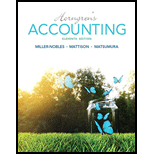
1)
Impact of
Adjusting entries are passed in the books of accounts at the end of the year to record certain transactions that are required to be journalized in order to comply with applicable regulatory and legal framework.
Examples of adjusting entries are recording of unearned revenue and amortization of intangible assets over their respective useful lives.
Impact of non-recording of adjusting entries on financial statements.
2)
Ethical Dilemmas in Accounting
Ethical Dilemmas in accounting refer to scenarios where one must put the interest of the stakeholders of the financial statements over one’s own personal interest. Example of such a scenario is understating of expenses and overstatement of revenues to present a healthier set of financial statements.
It can be difficult to do so but for the sake of the trust placed by the stakeholders in those charged with governance, personal interest must be placed second as compared to the professional responsibility.
Reasons for actions of Mr. Steinbach, Ethical validity and impacted parties by such action.
3)
Ethical Dilemmas in Accounting
Ethical Dilemmas in accounting refer to scenarios where one must put the interest of the stakeholders of the financial statements over one’s own personal interest. Example of such a scenario is understating of expenses and overstatement of revenues to present a healthier set of financial statements.
It can be difficult to do so but for the sake of the trust placed by the stakeholders in those charged with governance, personal interest must be placed second as compared to the professional responsibility.
Correct treatment for the adjusting entries.
Want to see the full answer?
Check out a sample textbook solution
Chapter 3 Solutions
Horngren's Accounting (11th Edition)
- MoonWear, Inc. offers an unconditional return policy. It normally expects 2.5% of sales at retail selling prices to be returned before the return period expires. Assuming that MoonWear records total sales of $12.5 million for the current period, what amount of net sales should it record for this period?arrow_forwardHi expert please given correct answer with accountingarrow_forwardHelp with accounting questionarrow_forward

 AccountingAccountingISBN:9781337272094Author:WARREN, Carl S., Reeve, James M., Duchac, Jonathan E.Publisher:Cengage Learning,
AccountingAccountingISBN:9781337272094Author:WARREN, Carl S., Reeve, James M., Duchac, Jonathan E.Publisher:Cengage Learning, Accounting Information SystemsAccountingISBN:9781337619202Author:Hall, James A.Publisher:Cengage Learning,
Accounting Information SystemsAccountingISBN:9781337619202Author:Hall, James A.Publisher:Cengage Learning, Horngren's Cost Accounting: A Managerial Emphasis...AccountingISBN:9780134475585Author:Srikant M. Datar, Madhav V. RajanPublisher:PEARSON
Horngren's Cost Accounting: A Managerial Emphasis...AccountingISBN:9780134475585Author:Srikant M. Datar, Madhav V. RajanPublisher:PEARSON Intermediate AccountingAccountingISBN:9781259722660Author:J. David Spiceland, Mark W. Nelson, Wayne M ThomasPublisher:McGraw-Hill Education
Intermediate AccountingAccountingISBN:9781259722660Author:J. David Spiceland, Mark W. Nelson, Wayne M ThomasPublisher:McGraw-Hill Education Financial and Managerial AccountingAccountingISBN:9781259726705Author:John J Wild, Ken W. Shaw, Barbara Chiappetta Fundamental Accounting PrinciplesPublisher:McGraw-Hill Education
Financial and Managerial AccountingAccountingISBN:9781259726705Author:John J Wild, Ken W. Shaw, Barbara Chiappetta Fundamental Accounting PrinciplesPublisher:McGraw-Hill Education





